Development of a Building Energy Simulation Model for Control of Multi-Span Greenhouse Microclimate
Abstract
1. Introduction
2. Materials and Methods
2.1. Experimental Greenhouse
2.2. Material Properties
2.3. BES Modeling
2.4. Validation
2.5. Simulation
- to predict the greenhouse heating load without thermal screens and with single-, double-, and triple-layered thermal screens and to compare them;
- to estimate the temperature of the greenhouse below and above each screen. All simulations were run with the 18 °C heating temperature setpoint; all other setpoints for ventilation and the thermal screen opening and closing were the same, as detailed in Table 4 in the Validation section;
- to predict the maximum heating load without thermal screens and with single, double, and triple thermal screens;
- to predict the heating load when using a combination of different thermal screens; and
- to predict the heating load with month-based day and night temperature setpoints.
3. Results and Discussion
4. Conclusions
Author Contributions
Funding
Conflicts of Interest
Nomenclature
| Abbreviations | |
| TRNSYS | Transient Systems Simulation |
| HG | Horticulture glass |
| PC | Polycarbonate |
| Ph-77 | Screen’s specific name |
| Ph-super | Screen’s specific name |
| BES | Building energy simulation |
| KMA | Korean Meteorological Administration |
| NSE | Nash–Sutcliffe efficiency coefficient |
| exp | Experimental |
| sim | Simulated |
| CFD | Computational Fluid Dynamics |
| Symbols | |
| W | Wind speed (m·s−1) |
| Ws | Wind speed at the given height (ms−1) |
| H | Hight (m) |
| α | Empirically derived coefficient (2/9 |
| Lb | Long-wave radiation above the screen (W·m−2) |
| La | Downward sky radiation (W·m−2) |
| Lc | Long-wave radiation equation over the black surface (W·m−2) |
| Ld | Incoming radiation above the black cloth (W·m−2) |
| Screen reflectivity | |
| Es | Screen’s emissive power (W·m−2) |
| Screen’s transmissivity | |
| Black cloth’s reflectivity | |
| Eb | Black cloth’s emissive power (W·m−2) |
| Ti | Air Temperature (°C) |
| Tb | Black cloth surface temperature (K) |
| emissivity of black cloth | |
| Stefan–Boltzmann constant ((W·m−2·K4) | |
References
- Rasheed, A.; Lee, J.W.; Lee, H.W. Development of a model to calculate the overall heat transfer coefficient of greenhouse covers. Span. J. Agric. Res. 2017, 15, 1–11. [Google Scholar] [CrossRef]
- Ghosal, M.K.; Tiwari, G.N. Mathematical modeling for greenhouse heating by using thermal curtain and geothermal energy. Sol. Energy 2004, 76, 603–613. [Google Scholar] [CrossRef]
- Kassai, M.; Al-Hyari, L.J.E. Investigation of ventilation energy recovery with polymer membrane material-based counter-flow energy exchanger for nearly zero-energy buildings. Energies 2019, 12, 1727. [Google Scholar] [CrossRef]
- Hemming, S.; Romero, E.B.; Mohammadkhani, V.; van Breugel, B. Energy Saving Screen Materials: Measurement Method of Radiation Exchange, Air Permeability and Humidity Transport and a Calculation Method for Energy Saving; Wageningen University & Research: Wageningen, The Netherlands; BU Greenhouse Horticulture: Wageningen, The Netherlands, 2017. [Google Scholar]
- Shakir, S.M.; Farhan, A.A. Movable thermal screen for saving energy inside the greenhouse. Assoc. Arab Univ. J. Eng. Sci. 2019, 26, 106–112. [Google Scholar] [CrossRef]
- Park, B.-S.; Kang, T.-H.; Han, C.-S. Analysis of heating characteristics using aluminum multi-layer curtain for protected horticulture greenhouses. J. Biosyst. Eng. 2015, 40, 193–200. [Google Scholar] [CrossRef][Green Version]
- Kim, H.-K.; Kang, G.-C.; Moon, J.-P.; Lee, T.-S.; Oh, S.-S. Estimation of thermal performance and heat loss in plastic greenhouses with and without thermal curtains. Energies 2018, 11, 578. [Google Scholar] [CrossRef]
- Kittas, C.; Katsoulas, N.; Baille, A. Influence of an aluminized thermal screen on greenhouse microclimate and canopy energy balance. Trans. ASAE 2003, 46, 1653–1663. [Google Scholar] [CrossRef]
- Geoola, F.; Kashti, Y.; Levi, A.; Brickman, R. A study of the overall heat transfer coefficient of greenhouse cladding materials with thermal screens using the hot box method. Polym. Test. 2009, 28, 470–474. [Google Scholar] [CrossRef]
- Rasheed, A.; Lee, J.W.; Lee, H.W. Evaluation of overall heat transfer coefficient of different greenhouse thermal screens using building energy simulation. Prot. Hortic. Plant Fact. 2018, 27, 294–301. [Google Scholar] [CrossRef]
- Gupta, M.J.; Chandra, P. Effect of greenhouse design parameters on conservation of energy for greenhouse environmental control. Energy 2002, 27, 777–794. [Google Scholar] [CrossRef]
- Gupta, R.; Tiwari, G.; Kumar, A.; Gupta, Y. Calculation of total solar fraction for different orientation of greenhouse using 3d-shadow analysis in auto-cad. Energy Build. 2012, 47, 27–34. [Google Scholar] [CrossRef]
- Sethi, V.P. On the selection of shape and orientation of a greenhouse: Thermal modeling and experimental validation. Sol. Energy 2009, 83, 21–38. [Google Scholar] [CrossRef]
- Rasheed, A.; Lee, J.; Lee, H. Development and optimization of a building energy simulation model to study the effect of greenhouse design parameters. Energies 2018, 11, 2001. [Google Scholar] [CrossRef]
- Kwon, S.-H.; Jung, S.-W.; Kwon, S.-G.; Park, J.-M.; Choi, W.-S.; Kim, J.-S. Comparative study on efficiencies of naturally-ventilated multi-span greenhouses in korea. J. Korean Soc. Ind. Converg. 2017, 20, 8–18. [Google Scholar] [CrossRef]
- Lee, I.-B.; Short, T.H. Two-dimensional numerical simulation of natural ventilation in a multi-span greenhouse. Trans. ASAE 2000, 43, 757. [Google Scholar]
- Short, T.H. Analysis of the efficiency of natural ventilation in a multi-span greenhouse using cfd simulation. Prot. Hortic. Plant Fact. 1999, 8, 9–18. [Google Scholar]
- Baeza, E.; Pérez-Parra, J.; Montero, J. Effect of ventilator size on natural ventilation in parral greenhouse by means of cfd simulations. In Proceedings of the International Conference on Sustainable Greenhouse Systems-Greensys2004, Leuven, Belgium, 12–16 September 2004; pp. 465–472. [Google Scholar]
- Villagrán, E.A.; Baeza Romero, E.J.; Bojacá, C.R. Transient cfd analysis of the natural ventilation of three types of greenhouses used for agricultural production in a tropical mountain climate. Biosyst. Eng. 2019, 188, 288–304. [Google Scholar] [CrossRef]
- Kim, R.-W.; Hong, S.-W.; Lee, I.-B.; Kwon, K.-S. Evaluation of wind pressure acting on multi-span greenhouses using cfd technique, part 2: Application of the cfd model. Biosyst. Eng. 2017, 164, 257–280. [Google Scholar] [CrossRef]
- Bronkhorst, A.J.; Geurts, C.P.W.; van Bentum, C.A.; van der Knaap, L.P.M.; Pertermann, I. Wind loads for stability design of large multi-span duo-pitch greenhouses. Front. Built Environ. 2017, 3, 18. [Google Scholar] [CrossRef]
- Kim, R.-W.; Lee, I.-B.; Kwon, K.-S. Evaluation of wind pressure acting on multi-span greenhouses using cfd technique, part 1: Development of the cfd model. Biosyst. Eng. 2017, 164, 235–256. [Google Scholar] [CrossRef]
- Ahamed, M.S.; Guo, H.; Tanino, K. Energy saving techniques for reducing the heating cost of conventional greenhouses. Biosyst. Eng. 2019, 178, 9–33. [Google Scholar] [CrossRef]
- López-Cruz, I.; Fitz-Rodríguez, E.; Salazar-Moreno, R.; Rojano-Aguilar, A.; Kacira, M. Development and analysis of dynamical mathematical models of greenhouse climate: A review. Eur. J. Hortic. Sci. 2018, 83, 269–279. [Google Scholar] [CrossRef]
- Ahamed, M.S.; Guo, H.; Taylor, L.; Tanino, K. Heating demand and economic feasibility analysis for year-round vegetable production in canadian prairies greenhouses. Inf. Process. Agric. 2019, 6, 81–90. [Google Scholar] [CrossRef]
- Ahamed, M.S.; Guo, H.; Tanino, K. A quasi-steady state model for predicting the heating requirements of conventional greenhouses in cold regions. Inf. Process. Agric. 2018, 5, 33–46. [Google Scholar] [CrossRef]
- Ahamed, M.S.; Guo, H.; Tanino, K. Development of a thermal model for simulation of supplemental heating requirements in chinese-style solar greenhouses. Comput. Electron. Agric. 2018, 150, 235–244. [Google Scholar] [CrossRef]
- Ahamed, M.S.; Guo, H.; Tanino, K. Energy-efficient design of greenhouse for canadian prairies using a heating simulation model. Int. J. Energy Res. 2018, 42, 2263–2272. [Google Scholar] [CrossRef]
- Lee, M.; Lee, I.-B.; Ha, T.-H.; Kim, R.-W.; Yeo, U.-H.; Lee, S.-Y.; Park, G.; Kim, J.-G.; Factory, P. Estimation on heating and cooling loads for a multi-span greenhouse and performance analysis of pv system using building energy simulation. Prot. Hortic. Plant Fact. 2017, 26, 258–267. [Google Scholar] [CrossRef]
- Rasheed, A.; Lee, J.W.; Lee, H.W. A review of greenhouse energy management by using building energy simulation. Prot. Hortic. Plant Fact. 2015, 24, 317–325. [Google Scholar] [CrossRef]
- Seo, I.-H.; Lee, I.-B.; Kwon, K.-S.; Park, S.-J.J.A.H. Bes computation for periodical energy load of greenhouse with geothermal heating system. Acta Hortic. 2014, 1037, 113–118. [Google Scholar]
- Chargui, R.; Sammouda, H.; Farhat, A. Geothermal heat pump in heating mode: Modeling and simulation on trnsys. Int. J. Refrig. 2012, 35, 1824–1832. [Google Scholar] [CrossRef]
- Klein, S.A. Trnsys, a Transient System Simulation Program; Solar Energy Laborataory, University of Wisconsin: Madison, WI, USA, 2012. [Google Scholar]
- Choab, N.; Allouhi, A.; El Maakoul, A.; Kousksou, T.; Saadeddine, S.; Jamil, A. Review on greenhouse microclimate and application: Design parameters, thermal modeling and simulation, climate controlling technologies. Sol. Energy 2019, 191, 109–137. [Google Scholar] [CrossRef]
- Baglivo, C.; Mazzeo, D.; Panico, S.; Bonuso, S.; Matera, N.; Congedo, P.M.; Oliveti, G. Complete greenhouse dynamic simulation tool to assess the crop thermal well-being and energy needs. Appl. Therm. Eng. 2020, 179, 115698. [Google Scholar] [CrossRef]
- Watts, D.; Jara, D. Statistical analysis of wind energy in chile. Renew. Energy 2011, 36, 1603–1613. [Google Scholar] [CrossRef]
- Valera, M.D.; Molina, A.F.; Alvarez, M.A. Protocolo de Auditoría Energética en Invernaderos. Auditoría Energética de un Invernadero para Cultivo de flor Cortada en Mendigorría; Instituto para la diversificacion y ahorro de la energia: Madrid, Spain, 2008. [Google Scholar]
- Rasheed, A.; Na, W.H.; Lee, J.W.; Kim, H.T.; Lee, H.W. Optimization of greenhouse thermal screens for maximized energy conservation. Energies 2019, 12, 3592. [Google Scholar] [CrossRef]
- Rafiq, A.; Na, W.H.; Rasheed, A.; Kim, H.T.; Lee, H.W.; Factory, P. Determination of thermal radiation emissivity and absorptivity of thermal screens for greenhouse. Prot. Hortic. Plant Fact. 2019, 28, 311–321. [Google Scholar] [CrossRef]
- Lee, H.-W.; Kim, Y.-S.; Sim, S.-Y.; Lee, J.-W.; Factory, P. Variation of vapor pressure deficit and condensation flux of air heating plastic greenhouse installed with two layers thermal curtain in winter. Prot. Hortic. Plant Fact. 2013, 22, 35–41. [Google Scholar] [CrossRef]
- Elings, A.; Kempkes, F.; Kaarsemaker, R.; Ruijs, M.; Van de Braak, N.; Dueck, T. The energy balance and energy-saving measures in greenhouse tomato cultivation. In Proceedings of the International Conference on Sustainable Greenhouse Systems-Greensys2004, Leuven, Belgium, 12–16 September 2004; pp. 67–74. [Google Scholar]
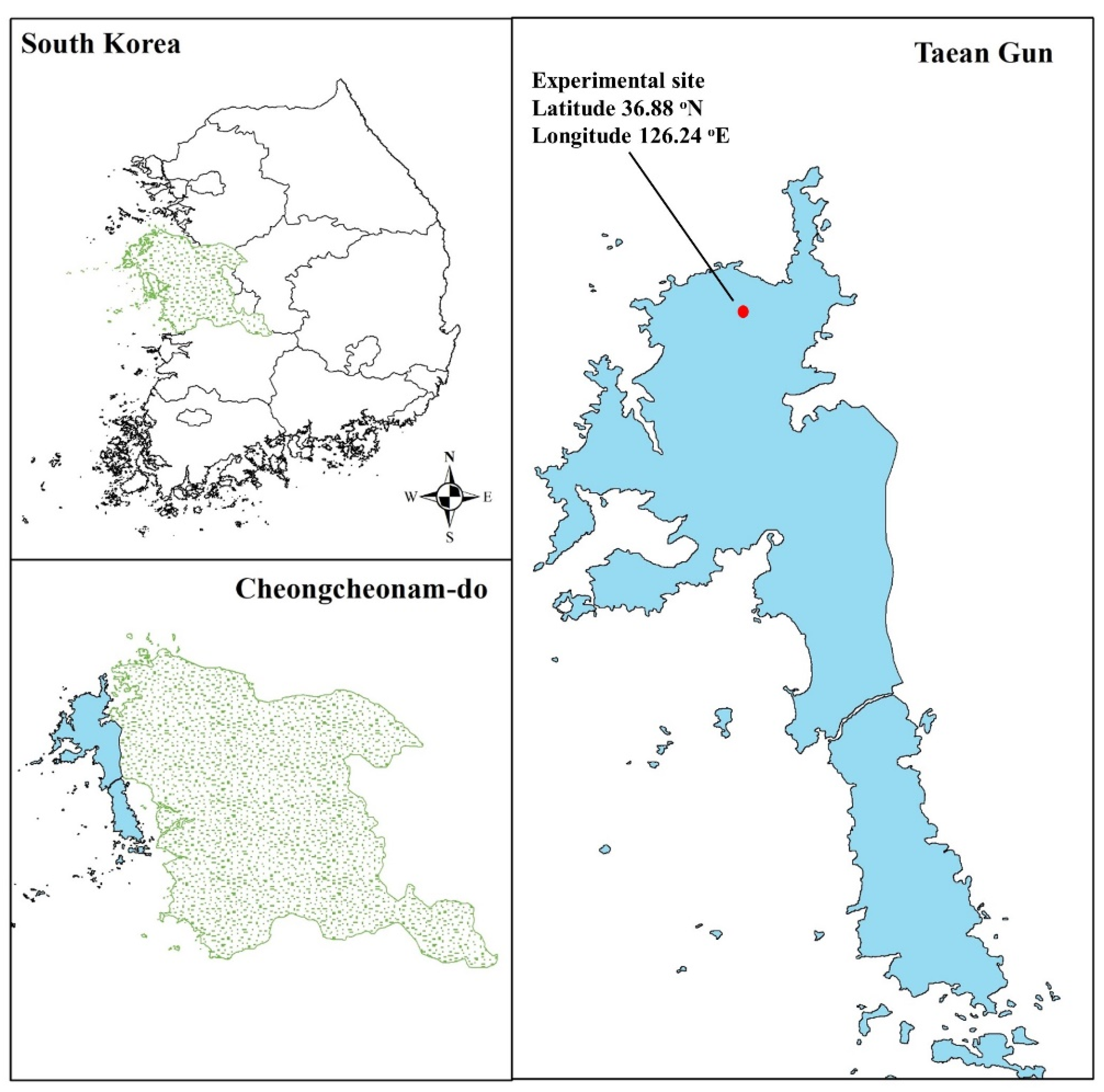


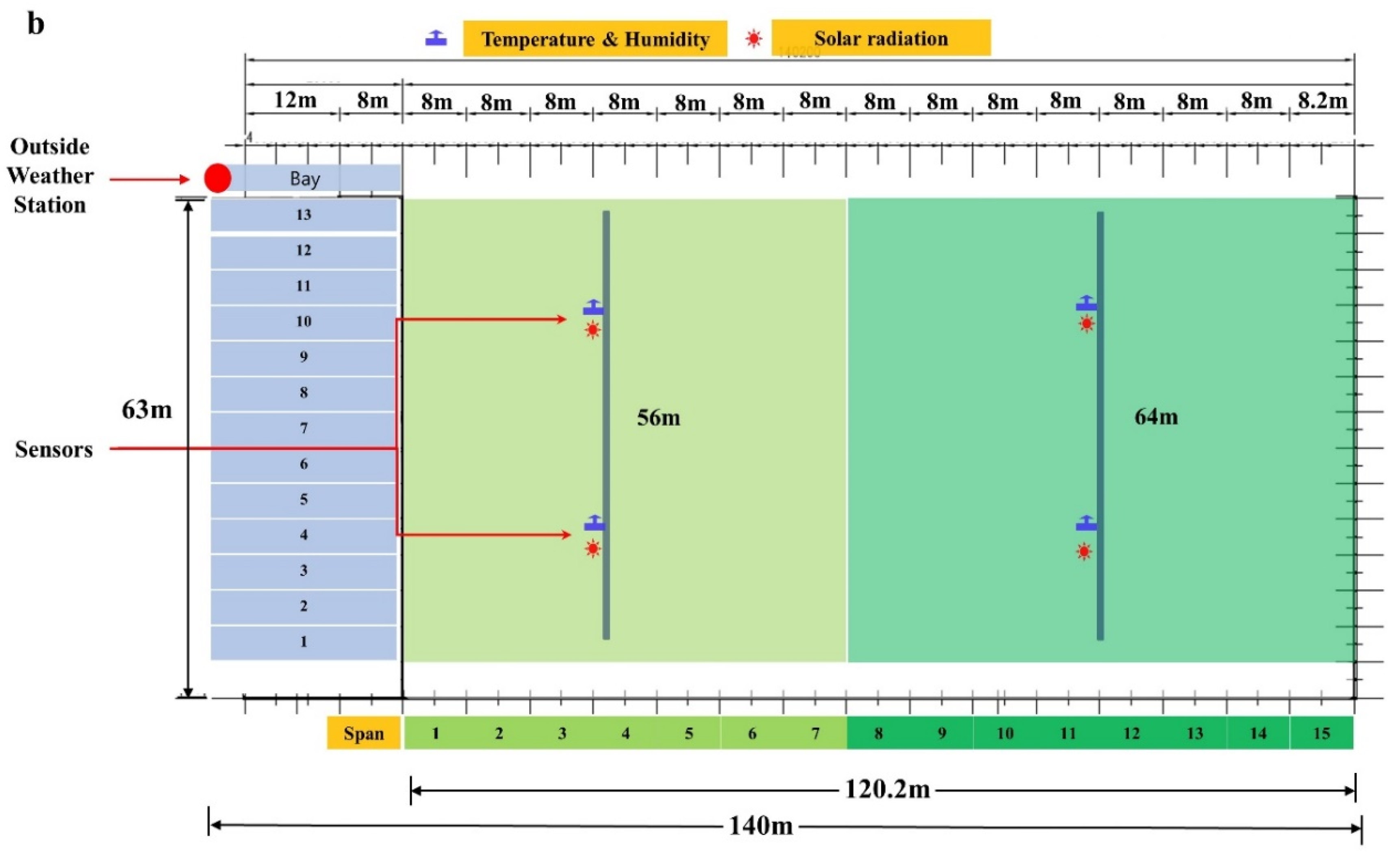
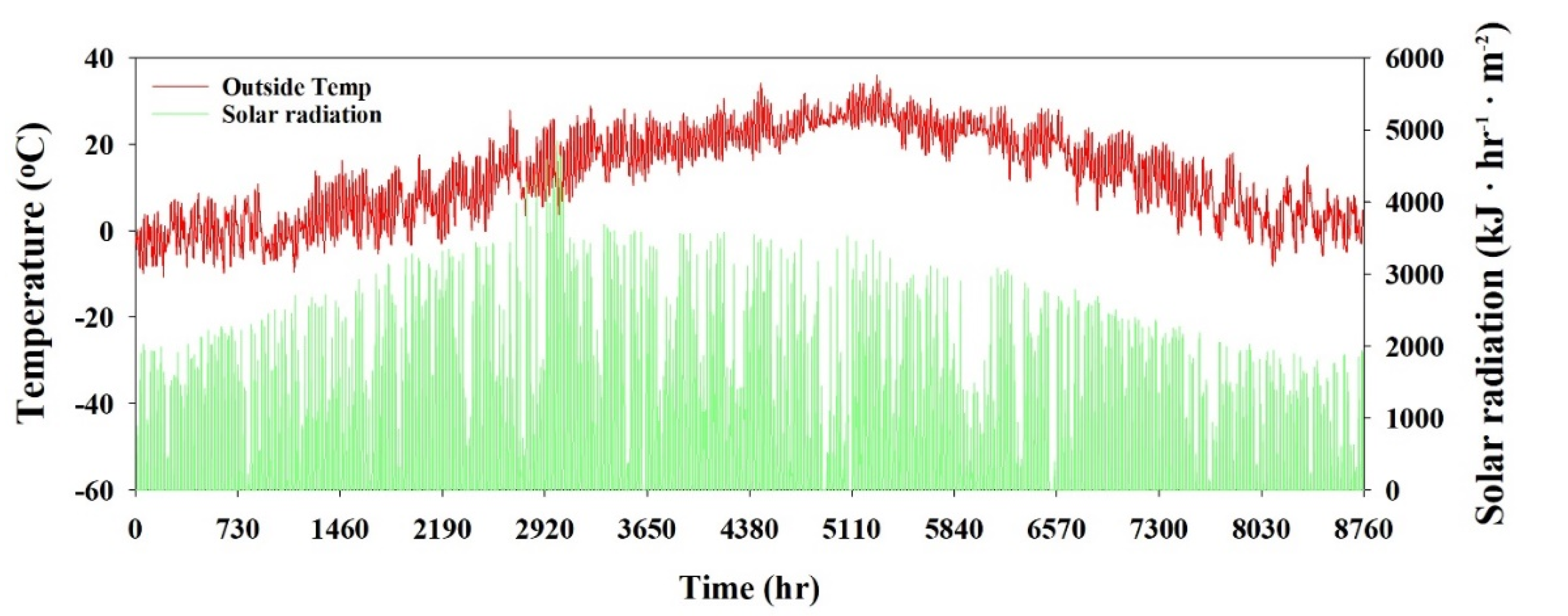
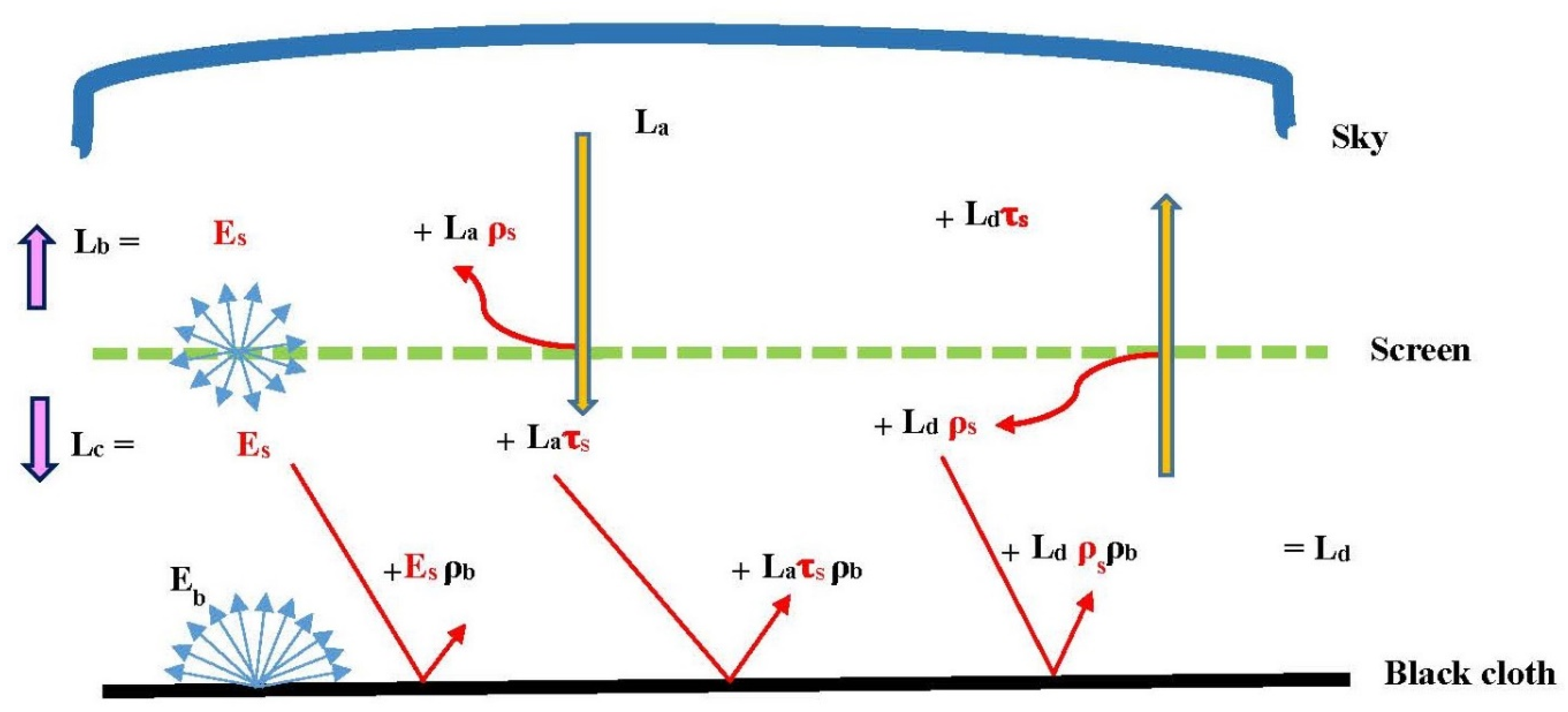


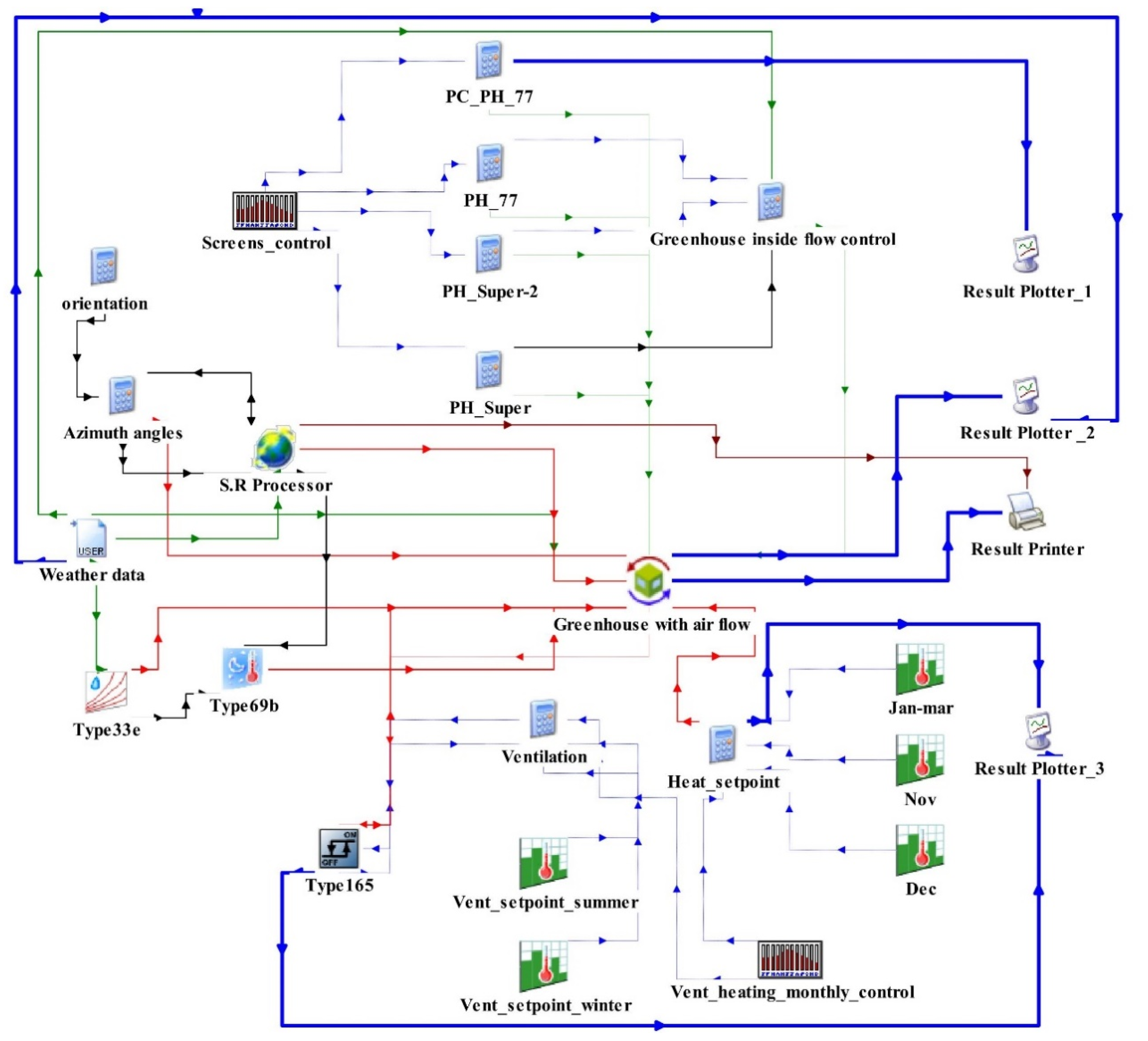
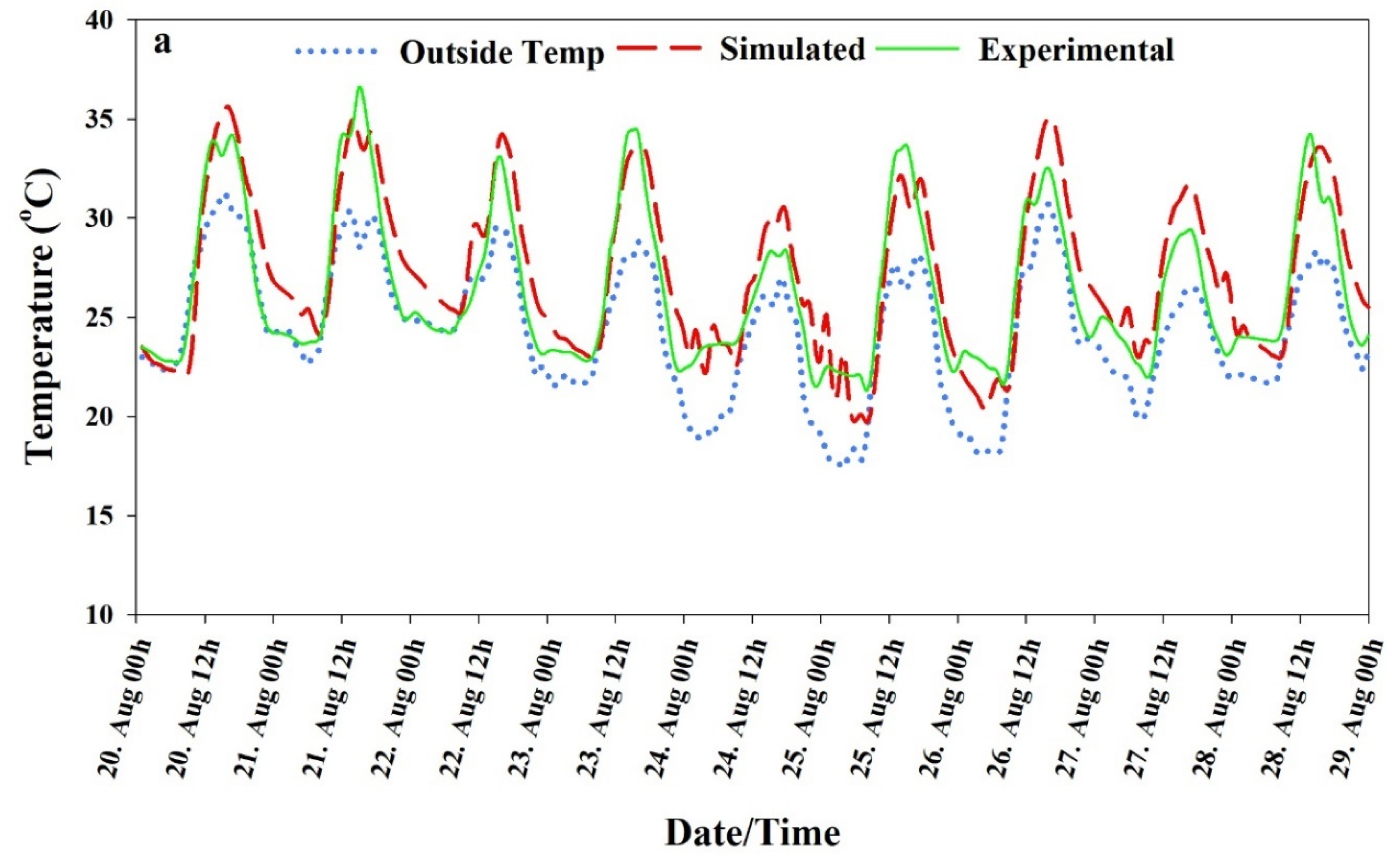
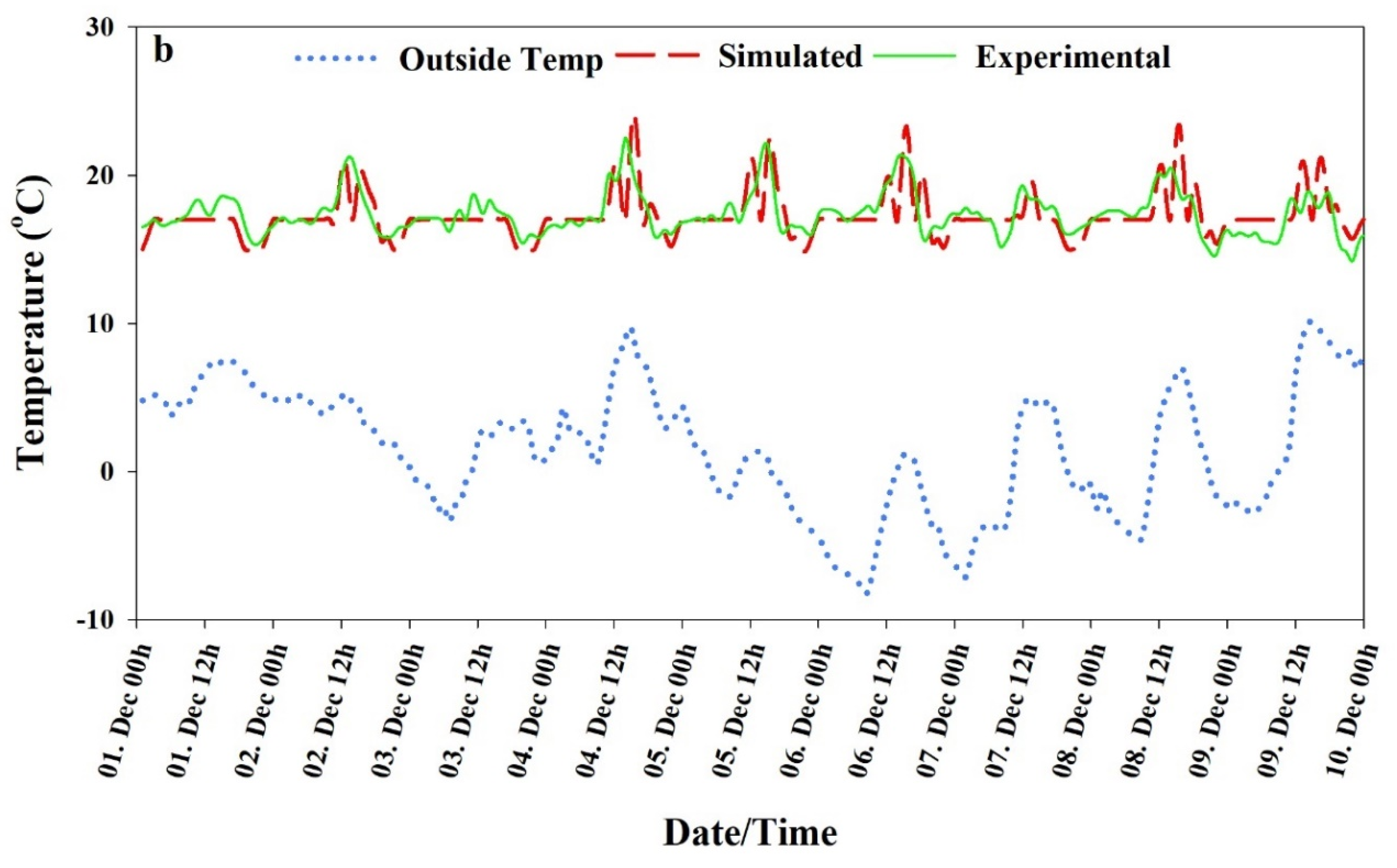

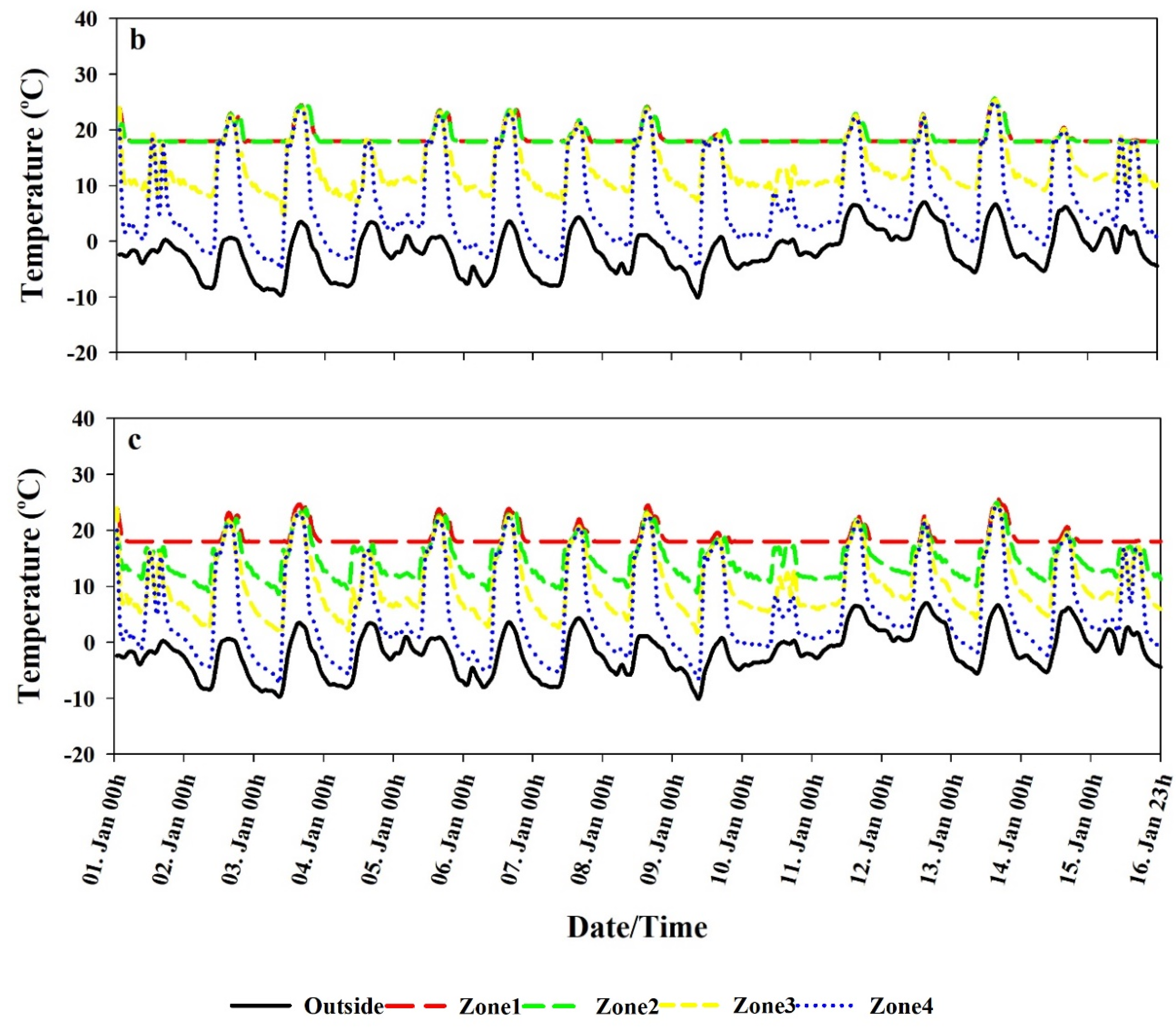
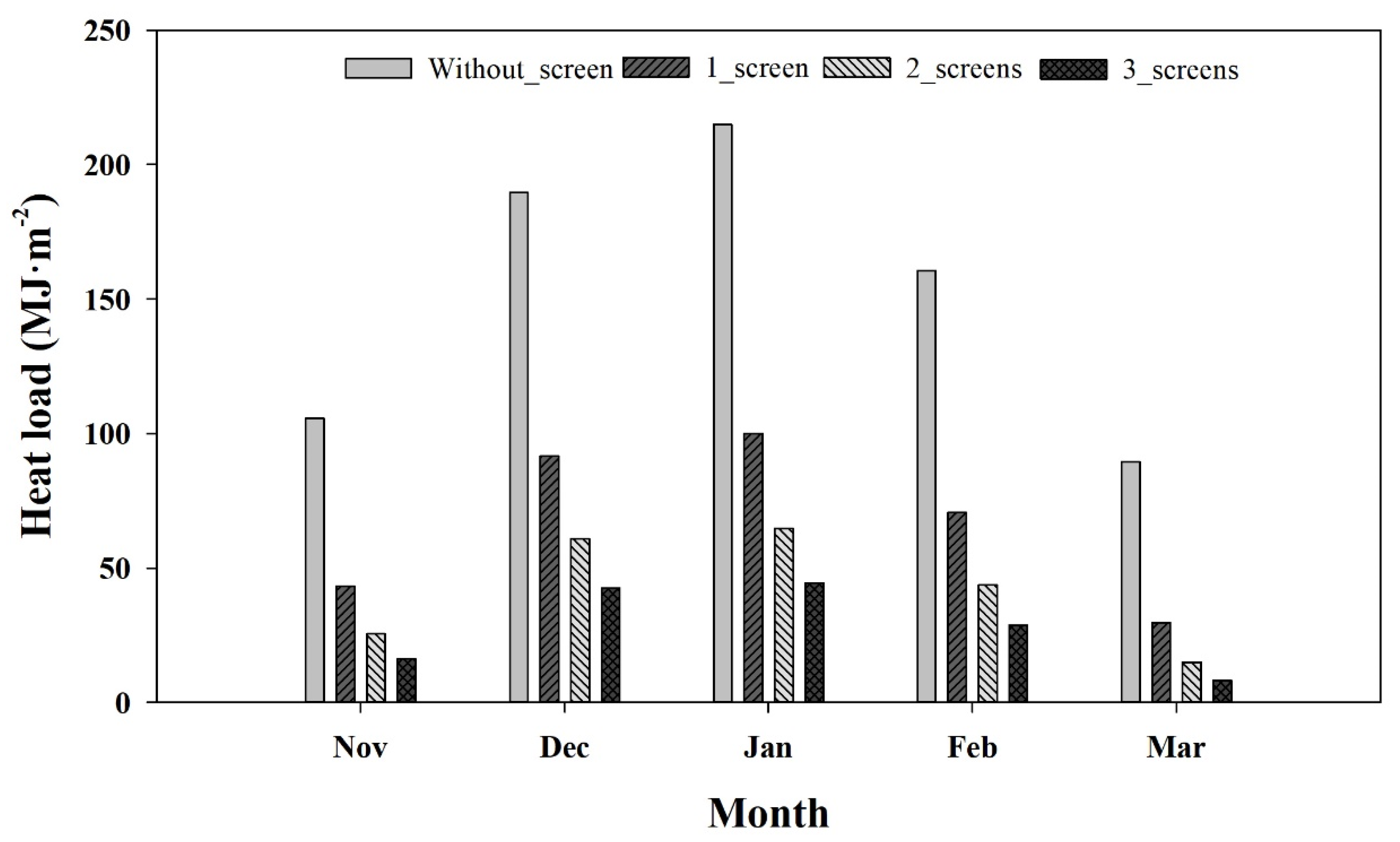
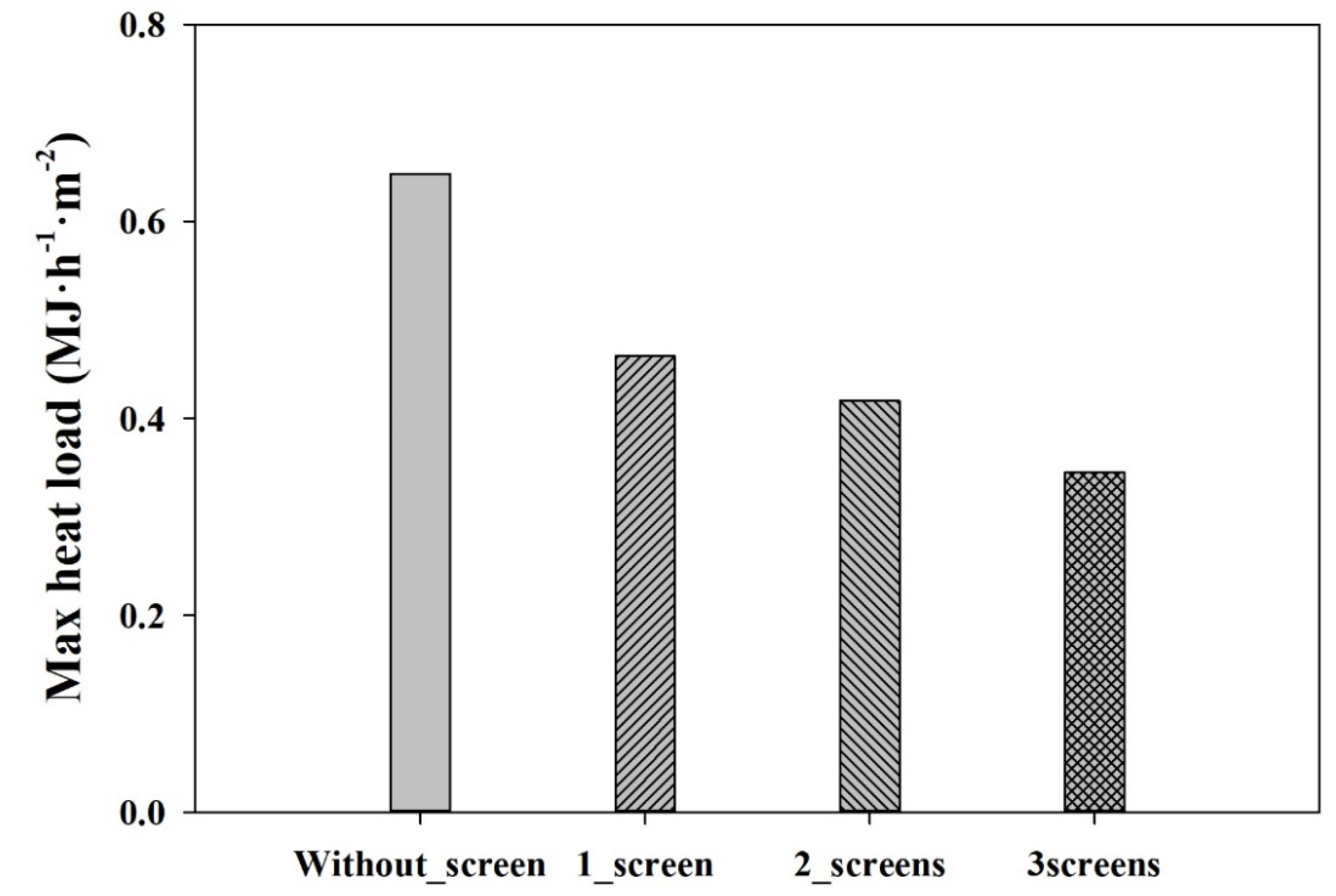
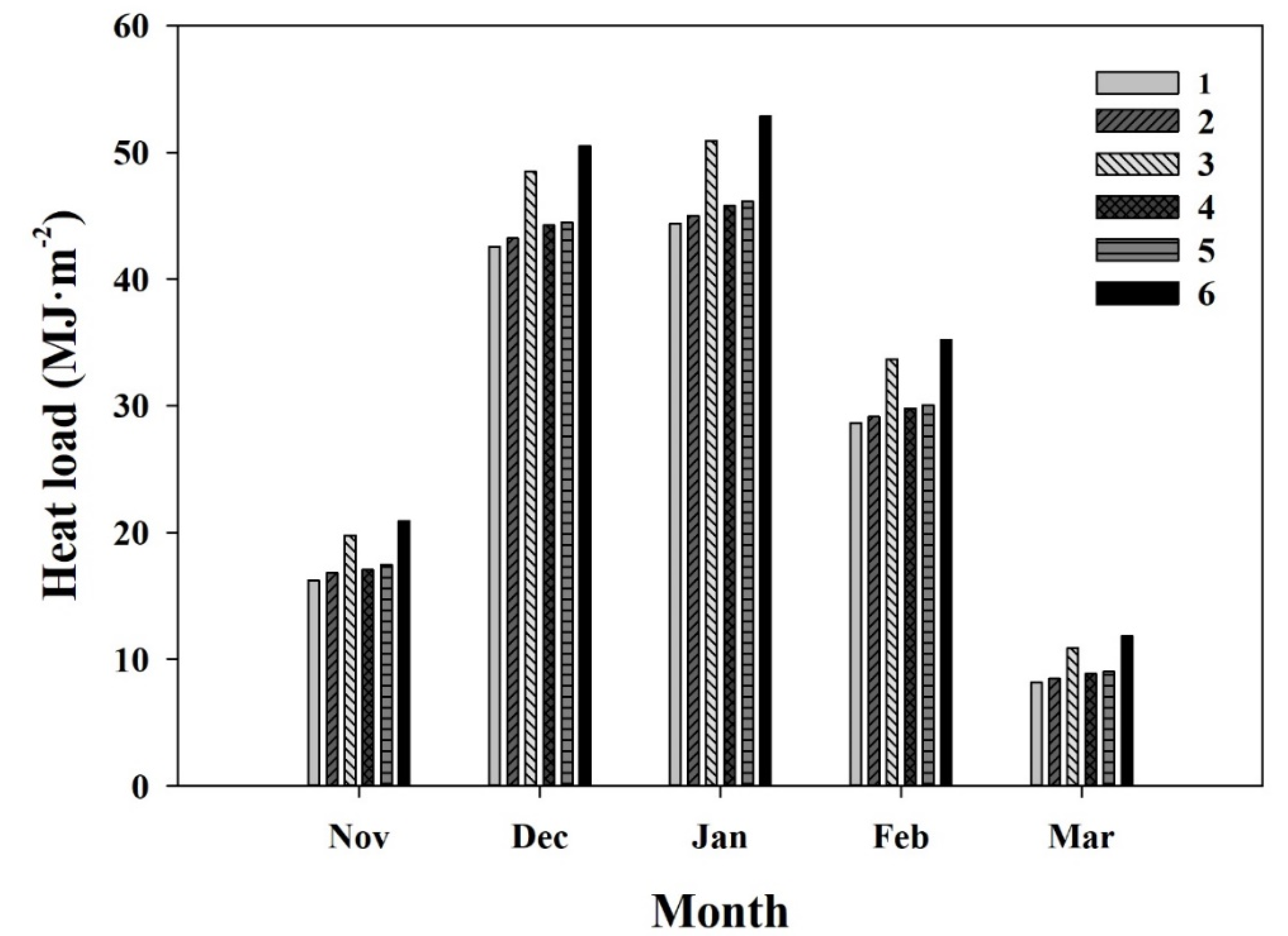

| Weather Parameter | Unit | Time Interval | Sensor | Precision of Sensor | Data Recorded |
|---|---|---|---|---|---|
| Temperature | °C | 1 min | IC, SHT75, SENSIRION | ±0.3 °C | Field recorded |
| Relative humidity | % | 1 min | IC, SHT75, SENSIRION | ±1.8% | Field recorded |
| Solar radiation | Wm−2 | 10 min | ML-01C, Technox Inc | ±2% | Field recorded |
| Wind speed | m s−1 | 10 min | Model_Vantage Pro 2 6152CEU (Davis) | ±5% | Field recorded |
| Wind direction | degree | 10 min | Model_Vantage Pro 2 6152CEU (Davis) | ±5% | Field recorded |
| Ambient pressure | hPa | 10 min | PTB-220TS, VAISALA | ±0.15 hPa | KMA |
| Cover Characteristics | Greenhouse Materials | |||
|---|---|---|---|---|
| PC | HG | Ph_77 | Ph_Super | |
| Solar transmittance front | 0.78 | 0.89 | 0.17 | 0.66 |
| Solar transmittance back | 0.78 | 0.89 | 0.17 | 0.66 |
| Solar reflectance front | 0.14 | 0.08 | 0.59 | 0.29 |
| Solar reflectance back | 0.14 | 0.08 | 0.51 | 0.29 |
| Visible radiation transmittance front | 0.75 | 0.91 | 0.17 | 0.66 |
| Visible radiation transmittance back | 0.75 | 0.91 | 0.17 | 0.66 |
| Visible radiation reflectance front | 0.15 | 0.08 | 0.59 | 0.29 |
| Visible radiation reflectance back | 0.15 | 0.08 | 0.51 | 0.29 |
| Thermal radiation transmittance | 0.02 | 0.1 | 0.20 | 0.38 |
| Thermal radiation emission front | 0.89 | 0.90 | 0.38 | 0.60 |
| Thermal radiation emission back | 0.89 | 0.90 | 0.48 | 0.60 |
| Conductivity (W m−1 K−1) | 0.190 | 0.76 | 0.59 | 0.08 |
| Thickness (mm) | 16 | 4 | 0.4 | 0.3 |
| Screen Types | Thickness (mm) | Conductivity (W·m−1·K−1) | Transmittance (—) | Reflectance (—) | Emittance (—) |
|---|---|---|---|---|---|
| Polyester | 0.4 | 0.0510 | 0.02 | 0.04 | 0.94 |
| Luxous1347 | 0.22 | 0.0463 | 0.38 | 0.18 | 0.44 |
| Tempa 8672 | 0.25 | 0.2133 | 0.01 | 0.32 | 0.67 |
| Component | Type | Description |
|---|---|---|
| Weather data reader | 9 | Process outside weather data to simulate real outside weather |
| Solar radiation processor | 16e | Process the total direct solar radiation on a horizontal surface provided by a weather data reader as input to calculate, beam, reflected, and diffuse radiation on all greenhouse surfaces |
| Psychrometric chart | 33 | Use dry bulk temperature and humidity ration and calculate dew point temperature |
| Sky temperature calculator | 69b | Calculate sky temperature by using dew point, dry bulk, temperature, beam, and diffuse radiation |
| Equation editor | This type was used to insert an equation. | |
| Greenhouse building model | 56-TRNFlow |
|
| Controller | 165 | This type is used to control signals for deployed and retracted screens and for opening and closing of vents for natural ventilation. |
| Monthly Function Scheduler | 518 | This type gives daily and monthly control signals to the controller. |
| Printer | 25d | This type was used to print results on the external file. |
| Plotter | 65c | This type was used to plot the results in an online plotter. |
| Parameter | Condition (a) | Condition (b) |
|---|---|---|
| Greenhouse type | Multi-span | Multi-span |
| No. of span | 15 | 15 |
| Roof type | Venlo | Venlo |
| Roof Glazing | HG-4mm | HG-4mm |
| Side Glazing | PC-16mm | PC-16mm |
| Dimension | 120 m × 63 m × 7.5 m | 120 m × 63 m × 7.5 m |
| Floor area | 7560 m2 | 7560 m2 |
| Orientation | North-South | North-South |
| Period | August 20–29, 2019 | Dec 1–10, 2019 |
| Screen | Shading (Ph-77) | Ph-77, Ph-Super |
| Screen control | Sunrise: 10:30 AM | Ph-77 retract (After sunrise, OR Temp 10, OR S.R 100W) Ph-77 Deploy (After sunset, OR Temp 12, AND S.R 100W Ph-Super_1 retract (After sunrise, OR Temp 5, OR S.R 50W) Ph-Super_1 deploy (After sunset, OR Temp 12, AND S.R 50W Ph-Super_2 retract (After sunrise, OR Temp 12, OR S.R 150W) Ph-Super_2 deploy (After sunset, OR Temp 14, AND S.R 150W |
| Natural ventilation | Roof vents | Roof vents |
| Natural vents control set point temperature | 18 °C (00:00–04:00) 20 °C (04:00–10:00) 26 °C (10:00–18:00) 18 °C (18:00–240:00) | 18 °C (00:00–05:30) 19 °C (05:30–16:15) 15 °C (16:15–21:30) 18 °C (21:30–24:00) |
| Heating | No | 17 °C (00:00–16:15) 15 °C (16:15–21:30) 17 °C (21:30–24:00) |
| 1 | 2 | 3 | 4 | 5 | 6 |
|---|---|---|---|---|---|
| Ph-77 + Ph-Super | Ph-77 + Luxous | Ph-77 + Polyester | Tempa + Ph-Super | Tempa + Luxous | Tempa + Polyester |
| Day and Night Temperature Control | |||
|---|---|---|---|
| Time | Nov | Dec | Jan–Mar |
| (00:00–16:15) | 18 °C | 17 °C | 17 °C |
| (16:15–21:30) | 15 °C | 15 °C | 14 °C |
| (21:30–24:00) | 18 °C | 17 °C | 17 °C |
| Fixed Temperature Control | |||
| (00:00–24:00) | 18 °C | 18 °C | 18 °C |
© 2020 by the authors. Licensee MDPI, Basel, Switzerland. This article is an open access article distributed under the terms and conditions of the Creative Commons Attribution (CC BY) license (http://creativecommons.org/licenses/by/4.0/).
Share and Cite
Rasheed, A.; Kwak, C.S.; Na, W.H.; Lee, J.W.; Kim, H.T.; Lee, H.W. Development of a Building Energy Simulation Model for Control of Multi-Span Greenhouse Microclimate. Agronomy 2020, 10, 1236. https://doi.org/10.3390/agronomy10091236
Rasheed A, Kwak CS, Na WH, Lee JW, Kim HT, Lee HW. Development of a Building Energy Simulation Model for Control of Multi-Span Greenhouse Microclimate. Agronomy. 2020; 10(9):1236. https://doi.org/10.3390/agronomy10091236
Chicago/Turabian StyleRasheed, Adnan, Cheul Soon Kwak, Wook Ho Na, Jong Won Lee, Hyeon Tae Kim, and Hyun Woo Lee. 2020. "Development of a Building Energy Simulation Model for Control of Multi-Span Greenhouse Microclimate" Agronomy 10, no. 9: 1236. https://doi.org/10.3390/agronomy10091236
APA StyleRasheed, A., Kwak, C. S., Na, W. H., Lee, J. W., Kim, H. T., & Lee, H. W. (2020). Development of a Building Energy Simulation Model for Control of Multi-Span Greenhouse Microclimate. Agronomy, 10(9), 1236. https://doi.org/10.3390/agronomy10091236






